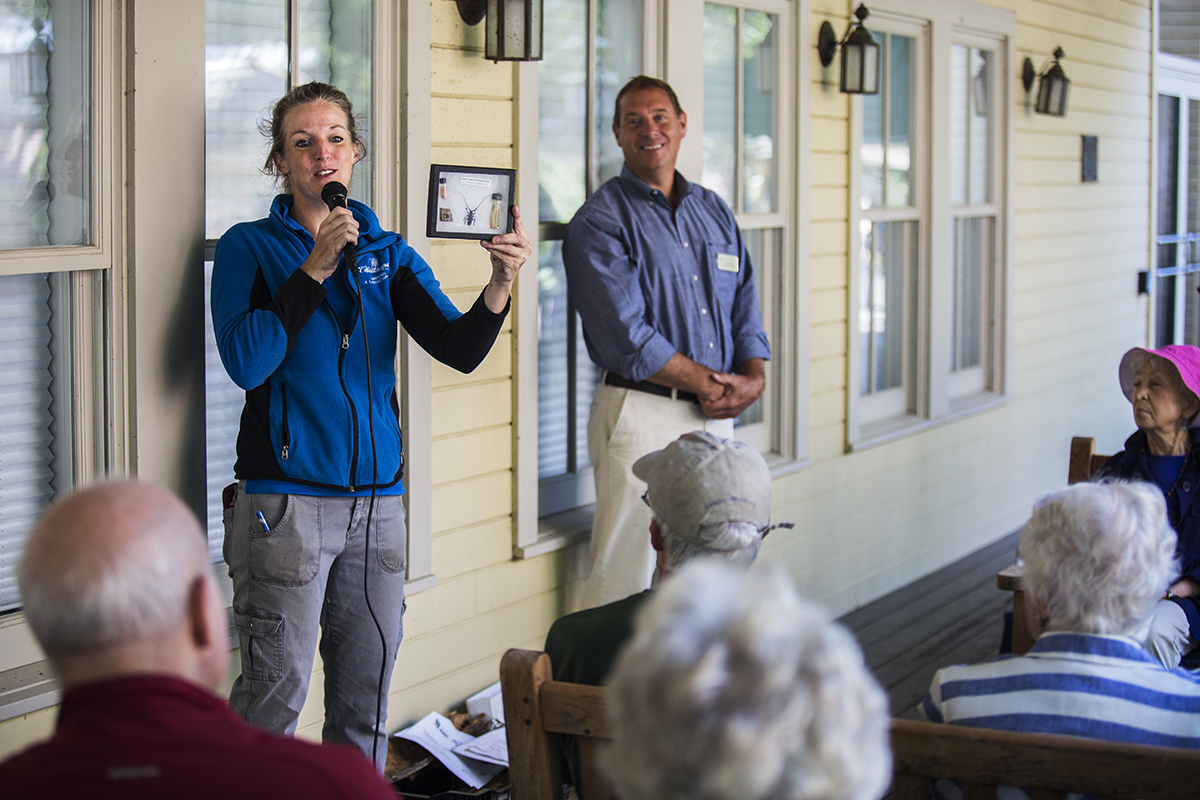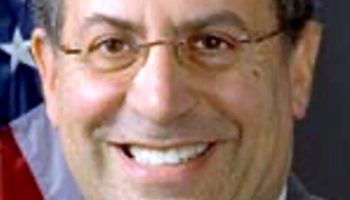Chautauqua Institution owns and cares for more than 6,000 trees on its grounds. That number excludes trees found on the land of property owners.
“We’re very fortunate to have a community that’s actually a forest,” said John Shedd, director of operations. “We consider it to be a forest and treat it like a forest, so we have forest management plans that we’re executing and continuing to maintain.”
Betsy Burgeson, supervisor of gardens and landscapes, said her department’s focus is to maintain, manage and protect the Institution’s trees so that they continue to support a sustainable environment for people, animals and the lake ecosystem.
Burgeson and Shedd spoke to a group of Chautauquans on “Tree Maintenance and Our Environment” at the Institution Leadership Porch Discussion Wednesday morning at the Hultquist Center.
“Trees are probably one of the most integral parts of our community,” Burgeson said. “As we develop our properties either on Institution grounds or within our own properties … the last thing we want to do is take out all these trees.”
Current land use regulations require homeowners to replace a tree in the event that a tree on their property needs to be removed.
According to Burgeson, more than 825 trees have been removed since 2015. That same year, 75 trees were planted, followed by 125 in 2016 and 65 so far in 2017, excluding the trees at the Amphitheater, which were not planted by her department.
In 2017, the New York State Department of Environmental Conservation included Chautauqua County in an emerald ash borer quarantine. EAB were found on the grounds during October 2015. The EAB is an Asian beetle that infests and kills different types of North American ash trees.
“All of our ash trees are under attack,” Burgeson said. “We have seen an enormous population explosion of the emerald ash borers.”
Burgeson passed out reference sheets to attendees with instructions on how to treat ash trees and how to obtain the help of a certified arborist. All homeowners with ash trees are being asked to either remove or treat them immediately. She encouraged homeowners to work together to schedule treatments of their trees to decrease the cost of the application, given the already costly price of the pesticide. Last year, 63 trees on Institution grounds were injected with a pesticide to treat the outbreak. According to Burgeson, another 24 are slated for injection this fall.
“The ash trees took the pesticide up very easily,” Burgeson said. “We’ve seen a tremendous response.”
None of the trees they’ve treated have died off.
Burgeson also warned against the possibility of oak wilt fungus. Out of the Institution’s top 10 largest trees, seven of them are red oaks, which are the most susceptible. Oak wilt can travel by beetles or underground through tree roots.
“If this comes in, we’re looking at a massive change in our landscape,” Burgeson said. “If anyone recognizes that an oak all of a sudden looked really good in June, then just really doesn’t, I’d like to know about it.”
She mentioned “brown from the top down” and abnormal leaf shedding as ways to recognize an ailing oak. Chautauqua County is not currently classified by the DEC as a protective zone. Various fungi are emerging because of the precipitation and moisture compared with last year’s drought.
“We don’t want to have a concrete jungle in here,” Burgeson said. “We want to keep this as our sanctuary, we want to keep this as our city in the woods.”
Another concern Shedd expressed is the lake. The lake is “impaired” because of excessive growths of weeds and algae. That growth is fueled by nitrogen and phosphorus that naturally occur in soil across the grounds and enter the lake as runoff.
“We’re trying to prevent those kinds of things from being detrimental to our lake,” Shedd said.
He noted trees as key absorbers of water and as plants that “help stabilize the soil around the lakeshore.”
During the Q-and-A segment, Susan Allen expressed concern about what she deemed “a lot of impermeable surfaces” across the grounds.
“Trees do not like impermeable surfaces,” Allen said. “It compacts the soil.”
According to Shedd, an impermeable or impervious surface is “any hard surface that won’t allow water to go through it.”
“All of our walkways that we’ve been putting in, the new products that we’ve been putting in, are semipermeable,” Shedd said. “It’s integral to the brick product that we use.”
Shedd said the Institution is working to keep things as permeable as possible, but also have to “balance safety, accessibility” with decisions like installing a ramp that would require a less permeable surface. The installation of asphalt and concrete driveways by homeowners is not permitted.
Burgeson added that there is more than 36,000 cubic feet of structure soil placed beneath the Amphitheater plaza so that tree roots aren’t stifled beneath the concrete. The subcontractor responsible for the trees around the Amp remains responsible for the upkeep of the trees for one year.
“As the gardens and landscaping department, we are not able to touch those trees because it will void the warranty,” Burgeson said.
More concerns were expressed about the plaza surrounding the Amphitheater, but Shedd assured attendees that “they’re not finished with the Amp yet.” More bike racks have been ordered and construction on Odland Plaza, the new area between the Smith Memorial Library and the Amp, will begin within a few months.
“We’re watching to see how things are used this year,” Shedd said. “We’re trying to determine where the natural movements are with people.”





